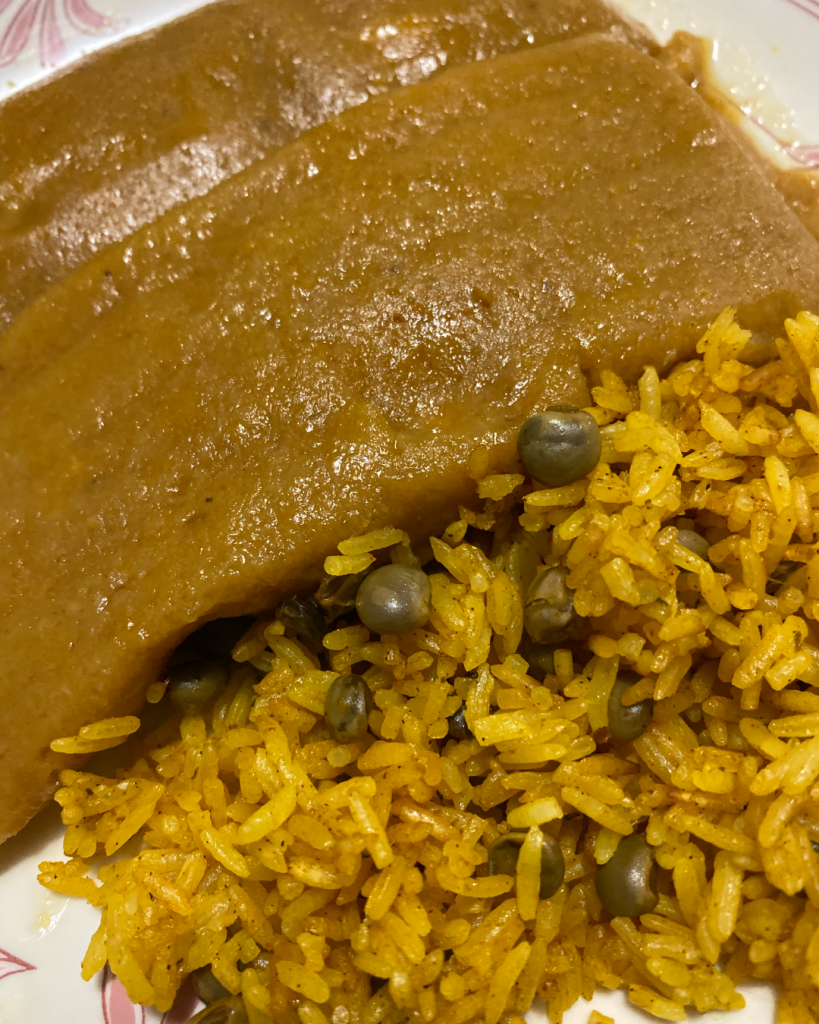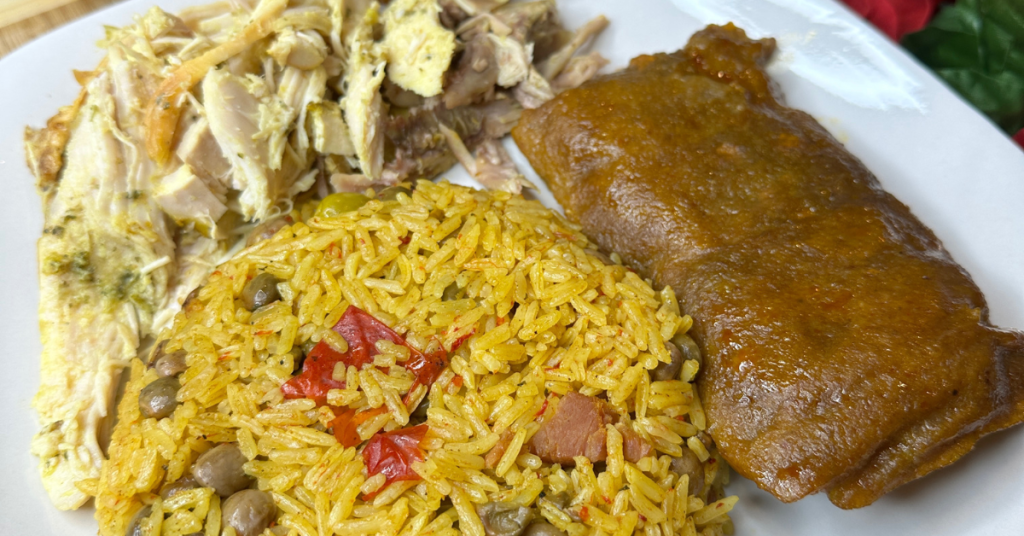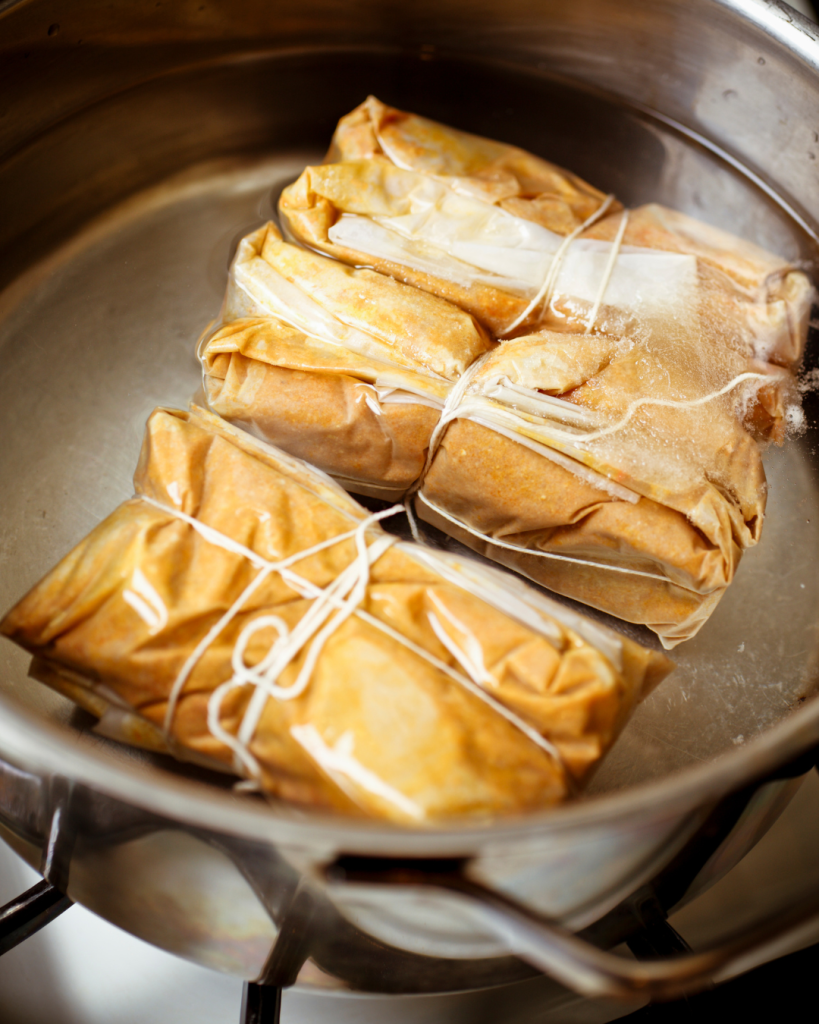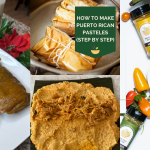You’ll find the beloved Puerto Rican Pasteles deep down in Puerto Rican culture.
Pasteles are much more than just a dish. They’re a classic tradition bringing families together during holidays and special occasions.
Imagine a special treat wrapped in a banana leaf filled with perfectly seasoned pork. The smell alone will take you to Puerto Rican Christmas when people enjoy these treats.
But don’t be intimidated by how they look at first. They may seem complicated, but they’re not. You can make Puerto Rican Pasteles in your very own kitchen.
This guide will unveil the secrets of making this unique cuisine. Learn how to make Pasteles and share its delicious flavors with your family and friends.
 The dough of Pasteles is a unique, delicious mix of root vegetables.
The dough of Pasteles is a unique, delicious mix of root vegetables.
 Christmas for Puerto Ricans is incomplete without the mouthwatering aroma of Pasteles. These delectable treats have become integral to Puerto Rican culture.
The story of Pasteles begins long before they appear in cookbooks. While the first written recipes didn’t come around until the 1930s, let’s travel back to 1843. Imagine a book called “El Aguinaldo Puertorriqueno,” all about Puerto Rican Christmas traditions. Pasteles was first introduced in this book, earning a special place in Puerto Rican Christmas cuisine (Jimenez, 2019).
The roots of Pasteles, however, go way back, all the way to when the Spanish came to Puerto Rico. At that time, our African ancestors played a big part in shaping Puerto Rican culture and creating Pasteles.
The idea of using banana leaves for wrapping Pasteles comes from our African ancestors. They were brought to Puerto Rico as enslaved people to work on sugar plantations for the Spanish. They didn’t have much to eat, mostly a simple diet of viendas, which included plantains. Plantains were looked down on by the Spanish colonizers and Puerto Rican elites.
But here’s the exciting part! The talented cooks of African and mixed heritage (mestizo) rose to the occasion. They took those plain ingredients and turned them into amazing dishes. Pasteles became a work of art, combining Indigenous, West African, and Spanish influences.
Pasteles are not just a tasty dish; they show respect for the Afro-Puerto Rican heritage. They remind us of their ability to turn limited resources into something delicious.
Think of Pasteles as a reminder of the strength and creativity of our ancestors. They didn’t have much to work with, but they transformed it into something mouthwatering.
Today, Pasteles are made with love in kitchens during the holiday season, not only in Puerto Rico but worldwide. Families gather to make big batches of these treasures. With every bite of Pasteles, we taste a piece of history, resilience, and tradition.
Christmas for Puerto Ricans is incomplete without the mouthwatering aroma of Pasteles. These delectable treats have become integral to Puerto Rican culture.
The story of Pasteles begins long before they appear in cookbooks. While the first written recipes didn’t come around until the 1930s, let’s travel back to 1843. Imagine a book called “El Aguinaldo Puertorriqueno,” all about Puerto Rican Christmas traditions. Pasteles was first introduced in this book, earning a special place in Puerto Rican Christmas cuisine (Jimenez, 2019).
The roots of Pasteles, however, go way back, all the way to when the Spanish came to Puerto Rico. At that time, our African ancestors played a big part in shaping Puerto Rican culture and creating Pasteles.
The idea of using banana leaves for wrapping Pasteles comes from our African ancestors. They were brought to Puerto Rico as enslaved people to work on sugar plantations for the Spanish. They didn’t have much to eat, mostly a simple diet of viendas, which included plantains. Plantains were looked down on by the Spanish colonizers and Puerto Rican elites.
But here’s the exciting part! The talented cooks of African and mixed heritage (mestizo) rose to the occasion. They took those plain ingredients and turned them into amazing dishes. Pasteles became a work of art, combining Indigenous, West African, and Spanish influences.
Pasteles are not just a tasty dish; they show respect for the Afro-Puerto Rican heritage. They remind us of their ability to turn limited resources into something delicious.
Think of Pasteles as a reminder of the strength and creativity of our ancestors. They didn’t have much to work with, but they transformed it into something mouthwatering.
Today, Pasteles are made with love in kitchens during the holiday season, not only in Puerto Rico but worldwide. Families gather to make big batches of these treasures. With every bite of Pasteles, we taste a piece of history, resilience, and tradition.
 One of the reasons why Pasteles hold such a place during Christmas is the labor of love that goes into making them. The intricate process of preparing these treats, from masa to filling, is time-consuming and demanding. The dedication needed reflects the genuine effort that goes into the holiday season.
One fascinating characteristic of Pasteles is how they resemble beautifully wrapped gifts. Pasteles are wrapped in banana leaves, making them a culinary delight and a visual treat. This presentation has a deep meaning in Puerto Rican Christmas tradition.
On January 6, Puerto Ricans celebrate El Día de Los Santos Reyes, honoring the three wise kings who brought gifts to Jesus Christ (Jimenez, 2019). Pasteles symbolize the spirit of giving, as they resemble a gift waiting to be unwrapped.
One of the reasons why Pasteles hold such a place during Christmas is the labor of love that goes into making them. The intricate process of preparing these treats, from masa to filling, is time-consuming and demanding. The dedication needed reflects the genuine effort that goes into the holiday season.
One fascinating characteristic of Pasteles is how they resemble beautifully wrapped gifts. Pasteles are wrapped in banana leaves, making them a culinary delight and a visual treat. This presentation has a deep meaning in Puerto Rican Christmas tradition.
On January 6, Puerto Ricans celebrate El Día de Los Santos Reyes, honoring the three wise kings who brought gifts to Jesus Christ (Jimenez, 2019). Pasteles symbolize the spirit of giving, as they resemble a gift waiting to be unwrapped.

What are Puerto Rican Pasteles Made Of?
 The dough of Pasteles is a unique, delicious mix of root vegetables.
The dough of Pasteles is a unique, delicious mix of root vegetables.
Ingredients for the dough:
- Yuca (cassava): Yuca adds a starchy and slightly nutty taste. It gives the dough structure and keeps it moist.Yautia (taro)
- Calabaza (tropical pumpkin): Calabaza brings a bit of sweetness. It also gives the dough a vibrant orange color.
- Green Bananas: Green bananas are peeled and processed into a paste, giving flavor and texture. They bring a subtle sweetness, making it the signature of Pasteles.
- Combining these ingredients gives you a flavorful dough ready to hold the filling.
Ingredients for Guiso:
- Pork or Chicken: You can choose pork or chicken based on your preference. Pork gives a rich, hearty flavor, while chicken is a lighter option. It’s all about personal taste.
- Adobo Seasoning: Adobo seasoning is a secret ingredient passed down through generations. It’s a blend of spices, herbs, and flavors. This seasoning gives the filling a savory taste that perfectly matches the meat.
What is the History of Puerto Rican Pasteles?
 Christmas for Puerto Ricans is incomplete without the mouthwatering aroma of Pasteles. These delectable treats have become integral to Puerto Rican culture.
The story of Pasteles begins long before they appear in cookbooks. While the first written recipes didn’t come around until the 1930s, let’s travel back to 1843. Imagine a book called “El Aguinaldo Puertorriqueno,” all about Puerto Rican Christmas traditions. Pasteles was first introduced in this book, earning a special place in Puerto Rican Christmas cuisine (Jimenez, 2019).
The roots of Pasteles, however, go way back, all the way to when the Spanish came to Puerto Rico. At that time, our African ancestors played a big part in shaping Puerto Rican culture and creating Pasteles.
The idea of using banana leaves for wrapping Pasteles comes from our African ancestors. They were brought to Puerto Rico as enslaved people to work on sugar plantations for the Spanish. They didn’t have much to eat, mostly a simple diet of viendas, which included plantains. Plantains were looked down on by the Spanish colonizers and Puerto Rican elites.
But here’s the exciting part! The talented cooks of African and mixed heritage (mestizo) rose to the occasion. They took those plain ingredients and turned them into amazing dishes. Pasteles became a work of art, combining Indigenous, West African, and Spanish influences.
Pasteles are not just a tasty dish; they show respect for the Afro-Puerto Rican heritage. They remind us of their ability to turn limited resources into something delicious.
Think of Pasteles as a reminder of the strength and creativity of our ancestors. They didn’t have much to work with, but they transformed it into something mouthwatering.
Today, Pasteles are made with love in kitchens during the holiday season, not only in Puerto Rico but worldwide. Families gather to make big batches of these treasures. With every bite of Pasteles, we taste a piece of history, resilience, and tradition.
Christmas for Puerto Ricans is incomplete without the mouthwatering aroma of Pasteles. These delectable treats have become integral to Puerto Rican culture.
The story of Pasteles begins long before they appear in cookbooks. While the first written recipes didn’t come around until the 1930s, let’s travel back to 1843. Imagine a book called “El Aguinaldo Puertorriqueno,” all about Puerto Rican Christmas traditions. Pasteles was first introduced in this book, earning a special place in Puerto Rican Christmas cuisine (Jimenez, 2019).
The roots of Pasteles, however, go way back, all the way to when the Spanish came to Puerto Rico. At that time, our African ancestors played a big part in shaping Puerto Rican culture and creating Pasteles.
The idea of using banana leaves for wrapping Pasteles comes from our African ancestors. They were brought to Puerto Rico as enslaved people to work on sugar plantations for the Spanish. They didn’t have much to eat, mostly a simple diet of viendas, which included plantains. Plantains were looked down on by the Spanish colonizers and Puerto Rican elites.
But here’s the exciting part! The talented cooks of African and mixed heritage (mestizo) rose to the occasion. They took those plain ingredients and turned them into amazing dishes. Pasteles became a work of art, combining Indigenous, West African, and Spanish influences.
Pasteles are not just a tasty dish; they show respect for the Afro-Puerto Rican heritage. They remind us of their ability to turn limited resources into something delicious.
Think of Pasteles as a reminder of the strength and creativity of our ancestors. They didn’t have much to work with, but they transformed it into something mouthwatering.
Today, Pasteles are made with love in kitchens during the holiday season, not only in Puerto Rico but worldwide. Families gather to make big batches of these treasures. With every bite of Pasteles, we taste a piece of history, resilience, and tradition.
Why Do Puerto Ricans Eat Pasteles During Christmas?
 One of the reasons why Pasteles hold such a place during Christmas is the labor of love that goes into making them. The intricate process of preparing these treats, from masa to filling, is time-consuming and demanding. The dedication needed reflects the genuine effort that goes into the holiday season.
One fascinating characteristic of Pasteles is how they resemble beautifully wrapped gifts. Pasteles are wrapped in banana leaves, making them a culinary delight and a visual treat. This presentation has a deep meaning in Puerto Rican Christmas tradition.
On January 6, Puerto Ricans celebrate El Día de Los Santos Reyes, honoring the three wise kings who brought gifts to Jesus Christ (Jimenez, 2019). Pasteles symbolize the spirit of giving, as they resemble a gift waiting to be unwrapped.
One of the reasons why Pasteles hold such a place during Christmas is the labor of love that goes into making them. The intricate process of preparing these treats, from masa to filling, is time-consuming and demanding. The dedication needed reflects the genuine effort that goes into the holiday season.
One fascinating characteristic of Pasteles is how they resemble beautifully wrapped gifts. Pasteles are wrapped in banana leaves, making them a culinary delight and a visual treat. This presentation has a deep meaning in Puerto Rican Christmas tradition.
On January 6, Puerto Ricans celebrate El Día de Los Santos Reyes, honoring the three wise kings who brought gifts to Jesus Christ (Jimenez, 2019). Pasteles symbolize the spirit of giving, as they resemble a gift waiting to be unwrapped.
Puerto Rican Pasteles

Puerto Rican Pasteles are a cherished traditional dish, featuring a unique blend of grated green bananas, plantains, and root vegetables. These savory parcels are filled with a variety of seasoned meats, wrapped in banana leaves, and boiled to perfection. A festive delicacy enjoyed during special occasions, Pasteles showcase the rich flavors and cultural heritage of Puerto Rican cuisine
- 5-6 pounds of meat (chicken thighs or pork belly)
- 3 tbsp oil of annatto “aceite de achiote” (or oil with sazón)
- 3 heaping tbsp sofrito
- 3 tbsp tomato sauce
- 1 tbsp minced garlic
- 5-6 culantro leaves (recao or cilantro)
- 3 tbsp pimento-stuffed olives
- 2-3 tsp. Healthy Rican Adobo and Sazón (to taste)
- Optional: 1 can of chickpeas
- 1 dozen Green bananas
- 10-12 pieces of yautia blanca (can be replaced with yuca)
- ½ small squash (calabaza)
- A dash of milk of choice or broth (to help blend the masa/dough)
- Banana leaves (found in the Latin frozen food section)
- Paper for pasteles and tamales (papel para pasteles)
- String
- Pre-cook the meat by steaming or boiling it. Typically cooks within 10-15 minutes. After completely cooked, remove from heat, strain any extra water, and add to a bowl. For the chicken, you can chop into small chunks or pull using 2 forks. Note: if using pork, chop into small chunks before cooking.
- In a large pot, add the oil, sofrito, tomato sauce, garlic, culantro, olives, and chickpeas. Stir fry for 1-2 minutes.
- Add the cooked meat with 1 cup of water. Add adobo and sazón to taste, stir well, and allow to boil for 5-8 minutes on high heat. If there is an excess of liquid, continue to cook on low heat, until the sauce thickens up. Remove from heat and set aside.
- Cut the corners of the green bananas. For easier peeling, place all the green bananas in a large bowl and cover with water. Allow to sit for a few minutes before you start.
- Peel and cut the yautia and squash into small chunks.
- Using a small knife, cut longways into the banana peel to open. Then chop into small pieces.
- In a large blender or food processor, blend all the chopped yautia, squash, and green bananas. For easier blending, add a bit of milk to get it started. Do small batches at a time and add the masa/dough into a large bowl.
- Add 2 tbsp of oil of annatto and 2 tbsp of the meat sauce to the masa/dough. If oil of annatto is not available, use oil of choice, and sazón or achiote molido (ground annatto). Mix well. Optional: Add salt to taste at this point.
- On a flat surface, place a rectangular piece of pastel paper (approximately 12×9”). Place a smaller rectangular piece of banana leaf on top.
- Spread 1 tsp of oil of annatto on top of the leaf.
- Add ¾ cup of masa/dough on top of the leaf and spread it out. It does not matter if it overflows to the paper.
- Add 2 tbs of meat along the middle of the dough.
- Quickly wrap the pasteles, and make sure the masa/dough does not come out through the sides. To do this, fold in both long sides, and bring in the corners.
- Place 2 pasteles together, making sure that the corners are facing each other.
- Using a 24″ long string, tie the pasteles together. Tight enough that they do not open during the cooking process.
- To cook, fill a large deep pot with water ¾ of the way. Bring to a boil and add the pasteles and make sure they are completely submerged. Allow to boil for 35-40 minutes.
- You can freeze the remaining pasteles for up to two months. When frozen, allow to cook for 45-50 minutes.
- Enjoy on their own, or with some hot sauce (or ketchup), and a pinch of salt if needed.


this Puerto Rican loves pasteles, with or without hojas de guineo. sure wish my Mami were still around to help us make them.